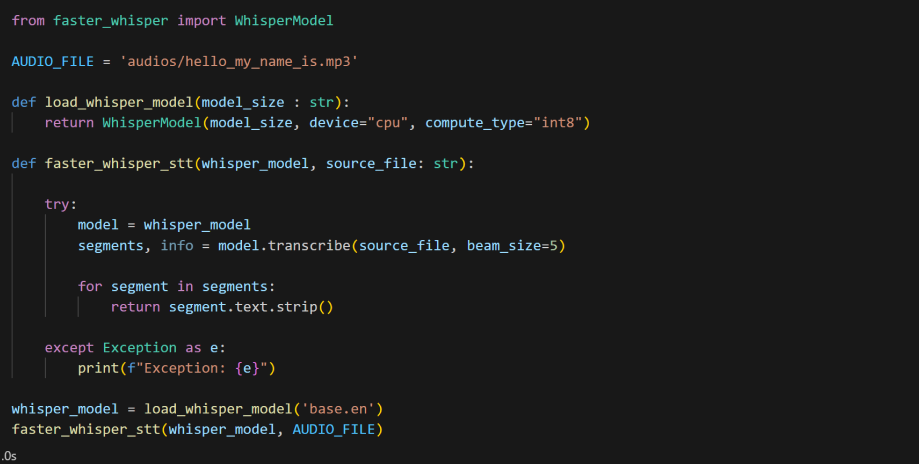
John Michael B. |
April 9, 2024
Unveiling the potential of speech-to-text engines: a comprehensive exploration
In the digital age, the ability to convert spoken words into written text through Speech-to-Text (STT) technology is revolutionizing the way we interact with our devices. From voice-activated assistants to transcription services, the applications of STT are vast and varied. In this blog post, we dive deep into the world of STT engines, exploring their capabilities, testing different models, and understanding their implications for developers and users alike.
The quest for understanding STT engines
At the heart of this exploration is a desire to grasp the intricacies of STT technology. For developers and tech enthusiasts, understanding the mechanics behind STT engines is crucial. It is not just about using technology; it is about immersing oneself in the technicalities and approaches that make STT possible. This journey into the world of STT aims to broaden knowledge and foster a deeper appreciation of this transformative technology.
Objectives and scope
The primary goal is to investigate various STT engines, focusing on those that are widely accessible and can be integrated into applications seamlessly. By delving inytsx to open-source options, this study emphasizes accessibility and the democratization of technology, ensuring that the insights gained can benefit a broad audience.
Study limitations
It is important to note that this exploration is grounded in the realm of open-source applications. This choice reflects a commitment to leveraging freely available resources, making the findings relevant and applicable to a wide range of developers and researchers.
Research requirements
To embark on this journey, a few tools are essential:
Diving into STT engine implementation

Speech recognition library
One of the first stops in this exploration is the Speech Recognition Library for Python. It supports several STT engines and APIs, making it a versatile tool for developers. A key step in using this library involves converting audio files to a format compatible with the chosen STT engine, typically `.wav`.

Faster-whisper: a leap forward
Faster-Whisper, a reimplementation of the original Whisper model from OpenAI, stands out for its support for GPU usage and quantized models. This results in faster and more efficient transcription, highlighting the advancements in STT technology.

Vosk: versatility in speech recognition
Vosk offers a toolkit for speech recognition that shines in offline use and on devices with limited resources. Its implementation involves loading specific models and employing a proprietary recognizer, demonstrating the flexibility and adaptability of STT engines.
Intended Sample Lines
“How much wood would a woodchuck chuck if a woodchuck could chuck wood?”
“Peter Piper picked a peck of pickled peppers.”
“Sally sells seashells by the seashore.”
“She sells seashells on the seashore; the shells that she sells are seashells, I’m sure.”
“The quick brown fox jumps over the lazy dog.”
Testing and insights
Creating test audio data, both from microphone recordings and pre-recorded clips, is crucial for evaluating the performance of STT engines. This study reveals that while STT technology has made significant strides, challenges remain, especially in transcribing audio with background noise or multiple speakers.
Microphone-Recorded Test Results:
Intended Sample Lines
Speech Recognition
Faster-Whisper
Vosk
“How much wood would a woodchuck chuck if a woodchuck could chuck wood?”
how much wood would a woodchuck chuck if a woodchuck could chuck wood
How much wood would a wood chop if a wood chop could chop wood?
how much would would a woodchuck chuck if a woodchuck could chuck wood
“Peter Piper picked a peck of pickled peppers.”
peter piper picked a peck of pickled peppers
Peter Piper Pig, a pack of pickled peppers.
peter piper picked a peck of pickled peppers
“Sally sells seashells by the seashore.”
sally sells seashells by the seashore
Sally sells seashells my DC short.
sally sells seashells by the seashore
“She sells seashells on the seashore; the shells that she sells are seashells, I’m sure.”
she sells seashells on the seashore the shells that she sells are the seashells i’m sure
She sells seashells on the seashore. The shells that she sells are the seashells, I’m sure.
she says seashells on the seashore the shells that she says are the seashells i’m sure
“The quick brown fox jumps over the lazy dog.”
the quick brown fox jumps over the lazy dog
The weak brown fox jumps over the lazy dog.
the quick brown fox jumps over the lazy
The importance of context and quality
The findings underscore the importance of audio quality and the controlled environment for accurate transcription. Moreover, the absence of punctuation in the output of some engines highlights an area for potential improvement, as punctuation is vital for understanding and context.
Looking ahead: recommendations for future research
As we look to the future, enhancing the contextual accuracy of STT systems is paramount. Incorporating models capable of adding punctuation and exploring real-time processing options are promising avenues for further research. The journey into the world of STT is far from over, and the potential for innovation is boundless.
Conclusion: embracing the potential of STT
In conclusion, the exploration of STT engines reveals a technology brimming with potential. While challenges remain, the advancements in STT are paving the way for more intuitive and accessible digital interactions. As we continue to explore and refine these technologies, the future of speech-to-text looks brighter than ever.